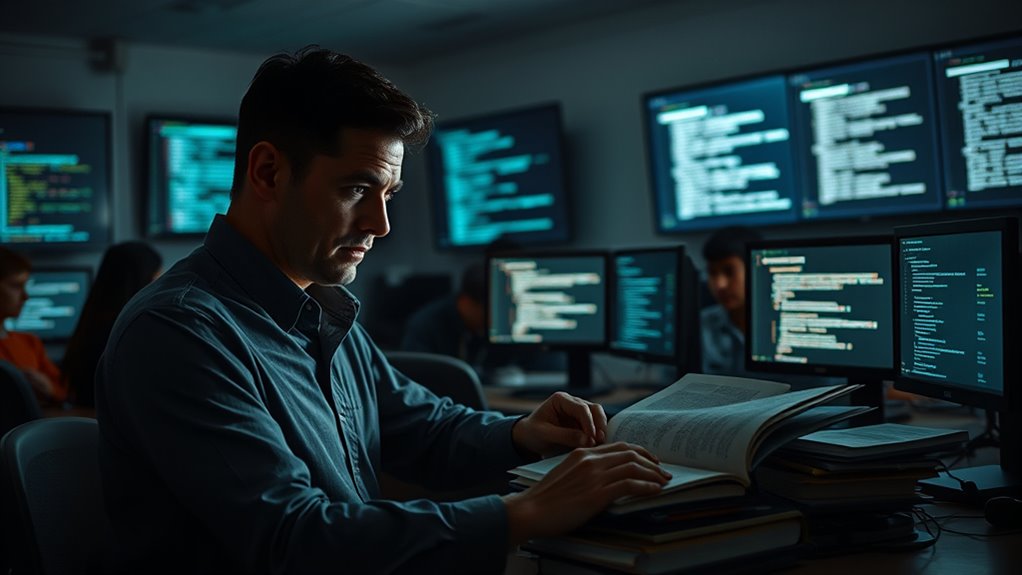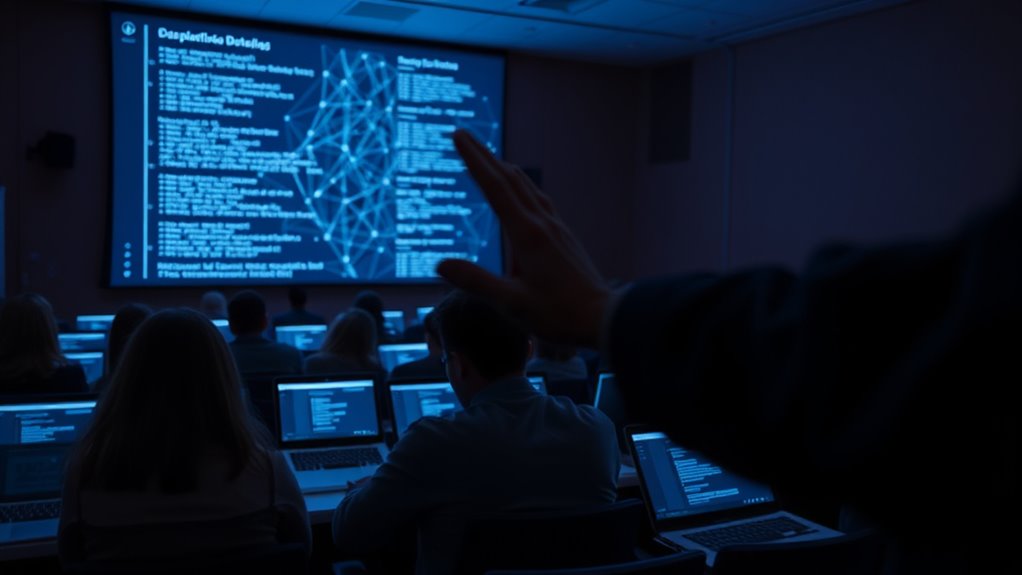Colleges are finding it increasingly hard to stop students from using AI tools to cheat. Students come up with clever ways to bypass plagiarism checkers, modify AI-generated work, or blend their own ideas with AI content. Traditional detection methods often fall short, pushing educators to change strategies. They’re turning to oral exams, project-based assessments, and fostering genuine understanding. Keep exploring how educational institutions are adapting to this evolving challenge to protect academic integrity.
Key Takeaways
- Students modify AI-generated content and combine it with personal input to evade detection tools.
- Traditional plagiarism checkers are ineffective against sophisticated AI-generated essays and solutions.
- Colleges are shifting to alternative assessments like oral exams and live projects to ensure authenticity.
- Continuous student innovation and tool development create an ongoing arms race with educators.
- Promoting a culture of integrity and genuine learning helps combat AI-assisted cheating effectively.

As artificial intelligence tools become more sophisticated, colleges are finding it increasingly difficult to prevent students from using them to cheat on assignments and exams. These AI-powered systems can generate essays, solve complex problems, and even mimic your writing style, making traditional plagiarism checks less effective. Many institutions rely on AI detection tools to identify suspicious work, but students have become remarkably resourceful at bypassing these measures. They tweak AI-generated content, insert human input, or use multiple tools to make their work seem more authentic. As a result, the line between genuine student effort and AI-assisted work blurs, challenging educators to develop new strategies. Additionally, advancements in heat pump technology demonstrate how innovations are continuously evolving to meet modern needs, much like educational strategies must adapt to new challenges.
AI advances blur the line between student effort and cheating, prompting educators to develop innovative assessment strategies.
You might think that AI detection software could be the ultimate safeguard, but it’s not foolproof. Students constantly innovate to stay ahead of these systems. They learn how to mask AI signatures or subtly modify generated text to evade detection. Some students even combine AI outputs with their own ideas, making it harder for algorithms to differentiate between original work and AI assistance. This student innovation creates a constant arms race between educators and learners, where each side adapts quickly to new tactics. Teachers and administrators now need to look beyond traditional detection methods, encouraging more authentic assessments that emphasize critical thinking and personal insight.
The growing use of AI tools also prompts a shift in how colleges approach learning. Instead of solely relying on exams or written assignments that are easy to cheat on, many institutions are emphasizing oral presentations, live problem-solving sessions, or project-based work. These methods require real-time engagement, making it tougher for students to outsource or automate their responses entirely. By fostering a culture of integrity and emphasizing the importance of genuine understanding, educators aim to diminish the appeal of AI-assisted cheating.
Despite these efforts, the challenge persists because student innovation is relentless. Students are quick to adapt, finding new loopholes and creative ways to use AI to their advantage. As colleges tighten their detection measures, students look for new tools, new techniques, and new ways to cheat while maintaining the appearance of academic integrity. This ongoing battle underscores the importance of cultivating a deeper educational environment—one that values original thought and personal growth over simply completing assignments. Ultimately, the goal isn’t just to catch cheaters but to inspire a genuine love of learning, where AI becomes a tool for enhancement rather than deception.
Frequently Asked Questions
How Effective Are Current AI Detection Tools?
Current AI detection tools are only moderately effective, as detection challenges persist. You might find they catch some AI-generated content, but students often outsmart them with subtle edits. This raises ethical implications about fairness and trust in academic integrity. While these tools help, you should be aware they aren’t foolproof, and ongoing improvements are necessary. Relying solely on technology without addressing underlying issues can undermine your confidence in assessment processes.
What Legal Measures Exist Against AI Cheating?
Legal frameworks are still catching up with AI cheating, but some policy developments aim to address this issue. You’ll find that new regulations focus on academic honesty and digital misconduct, holding students accountable for AI-assisted cheating. Schools and authorities are increasingly implementing policies that clarify consequences and promote fair use, but you should stay informed about evolving laws to guarantee you’re compliant and understand the risks involved.
How Are Students Responding to AI Detection Efforts?
You notice students respond to AI detection efforts with clever student tactics, such as paraphrasing or slightly modifying AI-generated content. They also use tools to obscure original writing, making it harder for plagiarism checkers to detect cheating. Despite these tactics, students often claim they’re upholding academic integrity, but their actions highlight ongoing challenges for colleges trying to ensure honest work. You see a constant battle to maintain genuine academic standards.
Can Ai-Generated Content Be Reliably Identified?
AI-generated content can’t be reliably identified yet because of current technological limitations. While tools exist, they often produce false positives or miss sophisticated AI writing, raising ethical implications about unfairly accusing students. You should understand that as AI evolves, detection methods also need to improve to balance technological capabilities with fairness. For now, rely on a combination of manual review and advanced detection tools, but stay aware of their limitations.
What Future Technologies Might Combat AI Plagiarism?
Future technologies might combat AI plagiarism through advanced AI detection tools that analyze writing patterns and verify authenticity. You’re likely to see innovations like blockchain-based credentialing and AI fingerprinting, which raise ethical implications around privacy and fairness. As technological advancements continue, you’ll need to stay informed about these tools’ limitations and make sure they’re used responsibly, fostering integrity while respecting students’ privacy and rights.
Conclusion
As you navigate this digital maze, remember that the fight against AI cheating is like chasing shadows in a moonlit night. Students constantly outsmart the safeguards, turning the game into a high-stakes chess match. But don’t lose hope—by staying vigilant and embracing innovative solutions, you can shine a light through the fog. Ultimately, it’s a battle of wits, and your perseverance is the spark that keeps the flame of academic integrity alive.











